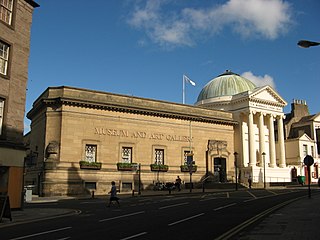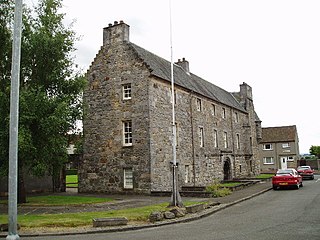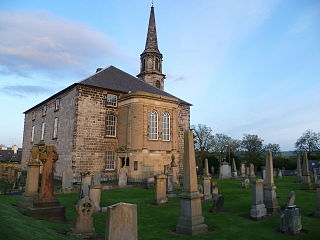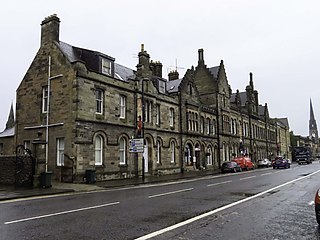
Moncreiffe House is a country house near Bridge of Earn in Perthshire in Scotland. It is a category B listed building. [1]

Moncreiffe House is a country house near Bridge of Earn in Perthshire in Scotland. It is a category B listed building. [1]

The original house was designed by Sir William Bruce in the classical style for Sir Thomas Moncreiffe, 1st Baronet and was completed in 1679. [1] [2]
It was the headquarters of the Polish I Corps, which was formed under Scottish Command in September 1940, during the Second World War. [3]
After the original house was completely destroyed by fire 1957, claiming the life of Sir David Moncreiffe of that Ilk, 10th Baronet and 23rd Laird, [4] it was rebuilt to a design by Sir William Kininmonth in 1962. [1] The old doorpiece from the original house was used in the construction of the new building. [1]
Part of the driveway leading to the house was built over in the 1980s during the construction of the M90 motorway. [5]
An ancient stone circle stands in the grounds of the house. [6]

Castle Menzies in Scotland is the ancestral seat of the Clan Menzies and the Menzies Baronets. It is located a little to the west of the small village of Weem, near Aberfeldy in the Highlands of Perthshire, close to the former site of Weem Castle, destroyed c. 1502.

Clan Robertson, also known as Clan Donnachaidh, Clan Donnachie, and Clan Duncan Scottish Gaelic: Clann Donnchaidh is a Scottish clan.

Sir Rupert Iain Kay Moncreiffe of that Ilk, 11th Baronet, Chief of Clan Moncreiffe, was a British Officer of Arms and genealogist.

Clan Moncreiffe is a Highland Scottish clan.

Perth Art Gallery is the principal art gallery and exhibition space in the city of Perth, Scotland. It is located in the Marshall Monument, named in memory of Thomas Hay Marshall, a former provost of Perth.

Fordell Castle is a restored 16th-century tower house, located 1.25 miles (2.01 km) north-west of Dalgety Bay and 2 miles (3.2 km) east of Dunfermline, in Fife, Scotland. Parts of the castle date from before 1566, though most dates from 1580 or later. The chapel was rebuilt in 1650. The interior of the castle was substantially renovated in the 1960s, with additional major renovations to the castle interiors and chapel in the early 2000s. The estate is in private ownership and not available for public tour.

Ochtertyre is a country house and estate in Perth and Kinross, Scotland. It is located in Strathearn, between Crieff and Loch Turret, north of the A85.

Fasque, also known as Fasque House or Fasque Castle, is a mansion in Aberdeenshire, Scotland, situated near the village of Fettercairn, in the former county of Kincardineshire.

Menstrie Castle is a three-storey manor house in the town of Menstrie, Clackmannanshire, near Stirling, central Scotland. From the early 17th century, it was home to Sir William Alexander, 1st Earl of Stirling, who was instrumental in founding the colony of Nova Scotia. It was later owned by the Holburn or Holborne family, who were created Baronets of Menstrie in 1706. The castle was restored in the 20th century, won a Civic Trust award, and now incorporates holiday accommodation, private flats, and a museum and cafe run by the National Trust for Scotland.

Mavisbank is a country house outside Loanhead, south of Edinburgh in Midlothian, Scotland. It was designed by architect William Adam in collaboration with his client, Sir John Clerk of Penicuik, and was constructed between 1723 and 1727. The first Palladian villa in Scotland, it is described by Historic Scotland as "one of Scotland's most important country houses". It was altered in the 19th century, but suffered decades of neglect in the 20th century. The interiors were gutted by fire in 1973, and the house remains a ruin. As of May 2009, plans exist to partially restore the building and manage the estate as a community asset.

Murthly is a village in Perth and Kinross, Scotland. It lies on the south bank of the River Tay, 5 miles southeast of Dunkeld, and 9+1⁄2 miles north of Perth. Perth District Asylum, later known as Murthly Hospital, was opened in the village on 1 April 1864 for 'pauper lunatics'. It was the second district asylum to be built in Scotland under the terms of the 1857 Lunacy (Scotland) Act. It closed in 1984 and was later demolished. The village has a stone circle, in the former grounds of the hospital. The village formerly had a railway station on the Perth and Dunkeld Railway, which closed in 1965.
The Hon. Peregrine David Euan Malcolm Hay, later Moncreiffe of that Ilk, Baron of Easter Moncreiffe and Chief of Clan Moncreiffe, is the second son of Sir Iain Moncreiffe of that Ilk, 11th Baronet Moncreiffe and Diana Denyse Hay, 23rd Countess of Errol. He is also the younger brother of Sir Merlin Sereld Victor Gilbert Hay, 12th Baronet Moncreiffe, 24th Earl of Erroll and Chief of Clan Hay.

Collace is a parish in Perthshire, Scotland, 8 miles northeast of Perth, in the Carse of Gowrie district. The parish boundary includes the neighbouring villages of Kinrossie and Saucher.
There have been three baronetcies created for people with the surname Moncreiffe or Moncreiff, two in the Baronetage of Nova Scotia and one in the Baronetage of the United Kingdom. Two of the titles are dormant, as the heir has not proved his descent, and one is extant, though its holder does not bear the surname of Moncreiffe.
Sir Thomas Moncreiffe, 7th Baronet was a Scottish first-class cricketer and British Army officer.

Ardkinglas House is a Category A listed country house on the Ardkinglas Estate in Argyll, Scotland. The estate lies on the eastern shore of Loch Fyne, and the house is located close to the village of Cairndow. Dating back to the 14th century and originally a Campbell property, the estate now covers more than 12,000 acres (4,900 ha) of rolling hills and landscaped parkland. The centre of the estate was Ardkinglas Castle until this was replaced by a new house in the 18th century. This house was itself replaced by the present Ardkinglas House in the early 20th century, designed by Sir Robert Lorimer for Sir Andrew Noble. It remains the property of the Noble family, and is open to the public on a limited basis. The woodland gardens are open all year round.

Midmar is a historic settlement in Aberdeenshire, lying north of Banchory and southwest of Inverurie. It is noted for its three stone circles and various standing stones. Midmar and Sunhoney are both recumbent stone circles.

Carlton Terrace is a residential street in Edinburgh, Scotland. It is located on the east side of Calton Hill, at the eastern extremity of the New Town, part of the UNESCO World Heritage Site inscribed in 1995.

St Michael’s Church, Inveresk is a Church of Scotland church serving the parish of Musselburgh: St Michael's Inveresk, in Scotland. Known as "the Visible Kirk" because of its prominent position at the top of the hill within the historic village of Inveresk, it is a Category A listed building.

62–72 Tay Street is an historic row of buildings in Perth, Scotland. Designed by local architect John Young, the building is Category B listed, dating to 1881. Standing on Tay Street, the building was originally the home of the Perthshire Society of Natural Science Museum, constructed in memory of Sir Thomas Moncreiffe, 7th Baronet, a past president of the society. The museum housed two exhibits: a local collection and The Type Museum, which illustrated the main types of animals, plants and rocks.